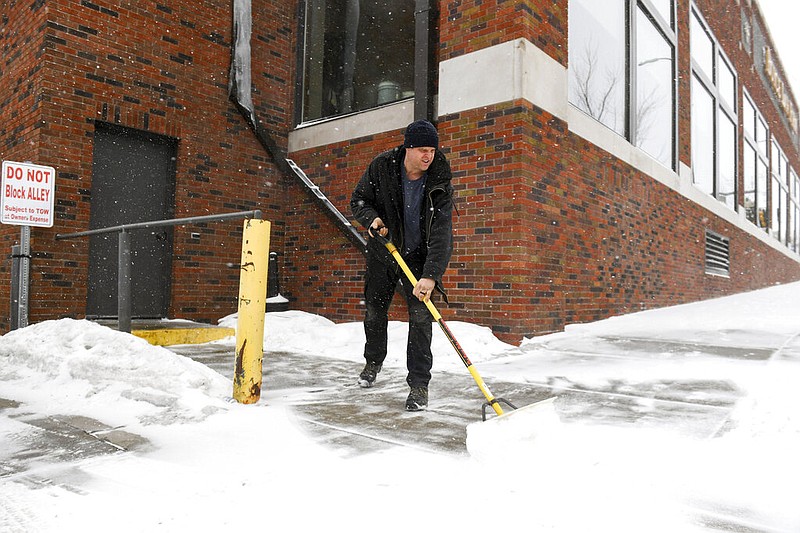MINNEAPOLIS — States in the northern plains are largely shutting down ahead of a massive winter storm that could dump up to 2 feet of snow in some areas, accompanied by strong winds and dangerously cold temperatures.
The blizzard-like conditions to the north are part of a wild weather day across the U.S. Wind gusts, combined with snow and rain, forced closure of a long stretch of interstate highway in the Southwest. Meanwhile, many places in the mid-Atlantic down to Florida are expected to see record high temperatures — in some cases up to 40 degrees above normal.
Many schools throughout the Dakotas, Minnesota and Wisconsin were called off for Wednesday, ahead of the storm. Offices closed, and so did the Minnesota Legislature. South Dakota Gov. Kristi Noem shut down state executive branch offices in several parts of the state, and employees were working remotely.
The storm will make its way toward the East Coast later in the week. Places that don't get snow may get dangerous amounts of ice. Forecasters expect up to a half-inch of ice in some areas of southern Michigan, northern Illinois and some eastern states.
The snowfall could be historic, even in a region accustomed to heavy snow. As much as 25 inches may pile up, with the heaviest amounts falling across east-central Minnesota and west-central Wisconsin, the National Weather Service said. Wind gusts could reach 50 mph and wind chills are expected to hit minus 50 degrees Fahrenheit in some parts of the Dakotas and Minnesota.
The Minneapolis-St. Paul area could see 2 feet of snow or more for the first time in over 30 years.
Some families scrambled Tuesday to get shopping done before the weather closed in. At a Costco in the Minneapolis suburb of St. Louis Park, Molly Schirmer stocked up on heat-and-serve dinners and Mexican Coca-Colas, knowing that she and her two teenagers might get stuck at home.
"The schools are already preparing to go online, so the kids will probably be home doing online school," Schirmer said of her 13- and 15-year-olds.
Temperatures in the nation's northern tier could plunge as low as minus 20 degrees Fahrenheit Thursday and to minus 25 degrees Fahrenheit Friday in Grand Forks, North Dakota. Wind chills may fall to minus 50 degrees Fahrenheit, said Nathan Rick, a meteorologist in Grand Forks.
Wind gusts may reach 50 mph in western and central Minnesota, resulting in "significant blowing and drifting snow with whiteout conditions in open areas," the weather service said.
According to the weather service, the biggest snow event on record in the Twin Cities was 28.4 inches from Oct. 31 through Nov. 3, 1991 — known as the Halloween Blizzard. The second-largest was 21.1 inches of snow from Nov. 29 through Dec. 1, 1985. The Twin Cities got 20 inches of snow on Jan. 22 and Jan. 23, 1982.
Hardware store owners said residents were generally taking the forecast in stride.
At C&S Supply, an employee-owned hardware store in Mankato, Minnesota, manager Corey Kapaun said demand was high for salt and grit, but not for shovels, snow blowers or other equipment. He attributed that to the fact that winter is two-thirds over.
"I think people are either prepared or they're not," Kapaun said. "It's usually the first snowfall of the year that gets a lot of attention. With a storm like this, I expected a little bit more, but we've already had a big year of snow already."
In Sioux Falls, Dallas VandenBos has owned Robson True Value hardware store for 48 years. His customers are used to the snow, but don't necessarily trust the forecast.
"When we had that storm the first part of January, they told us we were probably going to get 3 or 4 inches of snow, and we got 18 inches," VandenBos said.
Forecasters at AccuWeather said the same storm system could result in icing across a 1,300-mile band from near Omaha, Nebraska, to New Hampshire on Wednesday and Thursday, creating potential travel hazards in or near cities such as Milwaukee, Detroit, Chicago and Boston.
As the northern U.S. deals with a winter blast, record warmth is expected in the mid-Atlantic and Southeast — 30 degrees to 40 degrees above normal in some places. Record highs are expected from Baltimore to New Orleans and in much of Florida, National Weather Service Meteorologist Frank Pereira said.
Washington, D.C., could hit 80 degrees on Thursday, which would top the record of 78 degrees set in 1874.
A more than 200-mile stretch of Interstate 40 from central Arizona to the New Mexico line closed Wednesday morning due to wind gusts reaching up to 80 mph, plus snow and rain. Thousands were without power in Arizona.
California was also preparing for the latest in a series of winter storms as winds that began blowing Tuesday brought the potential for rain, snow and hail for much of the state. A "major snow event" was possible in foothills and mountains near Los Angeles, with several inches predicted even for elevations as low as 1,000 feet, the weather service said.
"Nearly the entire population of CA will be able to see snow from some vantage point later this week if they look in the right direction (i.e., toward the highest hills in vicinity)," UCLA climate scientist Daniel Swain wrote on Twitter.
Daytime temperatures in Southern California were unlikely to get out of the low to mid-50s and potentially damaging winds reaching 50 mph were predicted along the central coast, with gusts of 70 mph possible in mountains.
